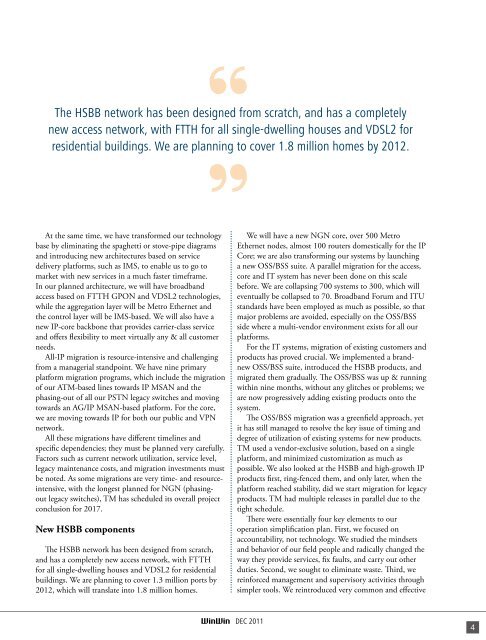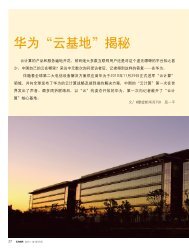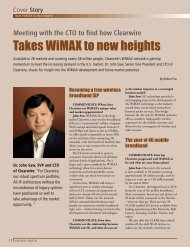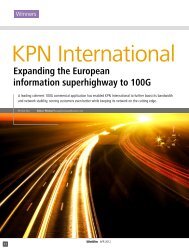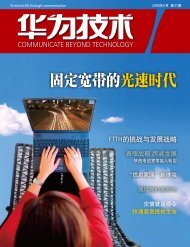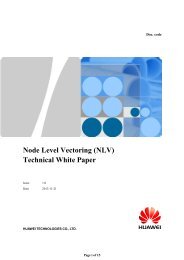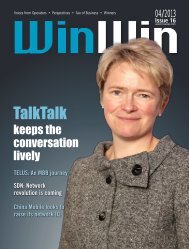Telekom Malaysia - Huawei
Telekom Malaysia - Huawei
Telekom Malaysia - Huawei
You also want an ePaper? Increase the reach of your titles
YUMPU automatically turns print PDFs into web optimized ePapers that Google loves.
The HSBB network has been designed from scratch, and has a completely<br />
new access network, with FTTH for all single-dwelling houses and VDSL2 for<br />
residential buildings. We are planning to cover 1.8 million homes by 2012.<br />
At the same time, we have transformed our technology<br />
base by eliminating the spaghetti or stove-pipe diagrams<br />
and introducing new architectures based on service<br />
delivery platforms, such as IMS, to enable us to go to<br />
market with new services in a much faster timeframe.<br />
In our planned architecture, we will have broadband<br />
access based on FTTH GPON and VDSL2 technologies,<br />
while the aggregation layer will be Metro Ethernet and<br />
the control layer will be IMS-based. We will also have a<br />
new IP-core backbone that provides carrier-class service<br />
and offers flexibility to meet virtually any & all customer<br />
needs.<br />
All-IP migration is resource-intensive and challenging<br />
from a managerial standpoint. We have nine primary<br />
platform migration programs, which include the migration<br />
of our ATM-based lines towards IP MSAN and the<br />
phasing-out of all our PSTN legacy switches and moving<br />
towards an AG/IP MSAN-based platform. For the core,<br />
we are moving towards IP for both our public and VPN<br />
network.<br />
All these migrations have different timelines and<br />
specific dependencies; they must be planned very carefully.<br />
Factors such as current network utilization, service level,<br />
legacy maintenance costs, and migration investments must<br />
be noted. As some migrations are very time- and resourceintensive,<br />
with the longest planned for NGN (phasingout<br />
legacy switches), TM has scheduled its overall project<br />
conclusion for 2017.<br />
New HSBB components<br />
The HSBB network has been designed from scratch,<br />
and has a completely new access network, with FTTH<br />
for all single-dwelling houses and VDSL2 for residential<br />
buildings. We are planning to cover 1.3 million ports by<br />
2012, which will translate into 1.8 million homes.<br />
We will have a new NGN core, over 500 Metro<br />
Ethernet nodes, almost 100 routers domestically for the IP<br />
Core; we are also transforming our systems by launching<br />
a new OSS/BSS suite. A parallel migration for the access,<br />
core and IT system has never been done on this scale<br />
before. We are collapsing 700 systems to 300, which will<br />
eventually be collapsed to 70. Broadband Forum and ITU<br />
standards have been employed as much as possible, so that<br />
major problems are avoided, especially on the OSS/BSS<br />
side where a multi-vendor environment exists for all our<br />
platforms.<br />
For the IT systems, migration of existing customers and<br />
products has proved crucial. We implemented a brandnew<br />
OSS/BSS suite, introduced the HSBB products, and<br />
migrated them gradually. The OSS/BSS was up & running<br />
within nine months, without any glitches or problems; we<br />
are now progressively adding existing products onto the<br />
system.<br />
The OSS/BSS migration was a greenfield approach, yet<br />
it has still managed to resolve the key issue of timing and<br />
degree of utilization of existing systems for new products.<br />
TM used a vendor-exclusive solution, based on a single<br />
platform, and minimized customization as much as<br />
possible. We also looked at the HSBB and high-growth IP<br />
products first, ring-fenced them, and only later, when the<br />
platform reached stability, did we start migration for legacy<br />
products. TM had multiple releases in parallel due to the<br />
tight schedule.<br />
There were essentially four key elements to our<br />
operation simplification plan. First, we focused on<br />
accountability, not technology. We studied the mindsets<br />
and behavior of our field people and radically changed the<br />
way they provide services, fix faults, and carry out other<br />
duties. Second, we sought to eliminate waste. Third, we<br />
reinforced management and supervisory activities through<br />
simpler tools. We reintroduced very common and effective<br />
DEC 2011<br />
4


